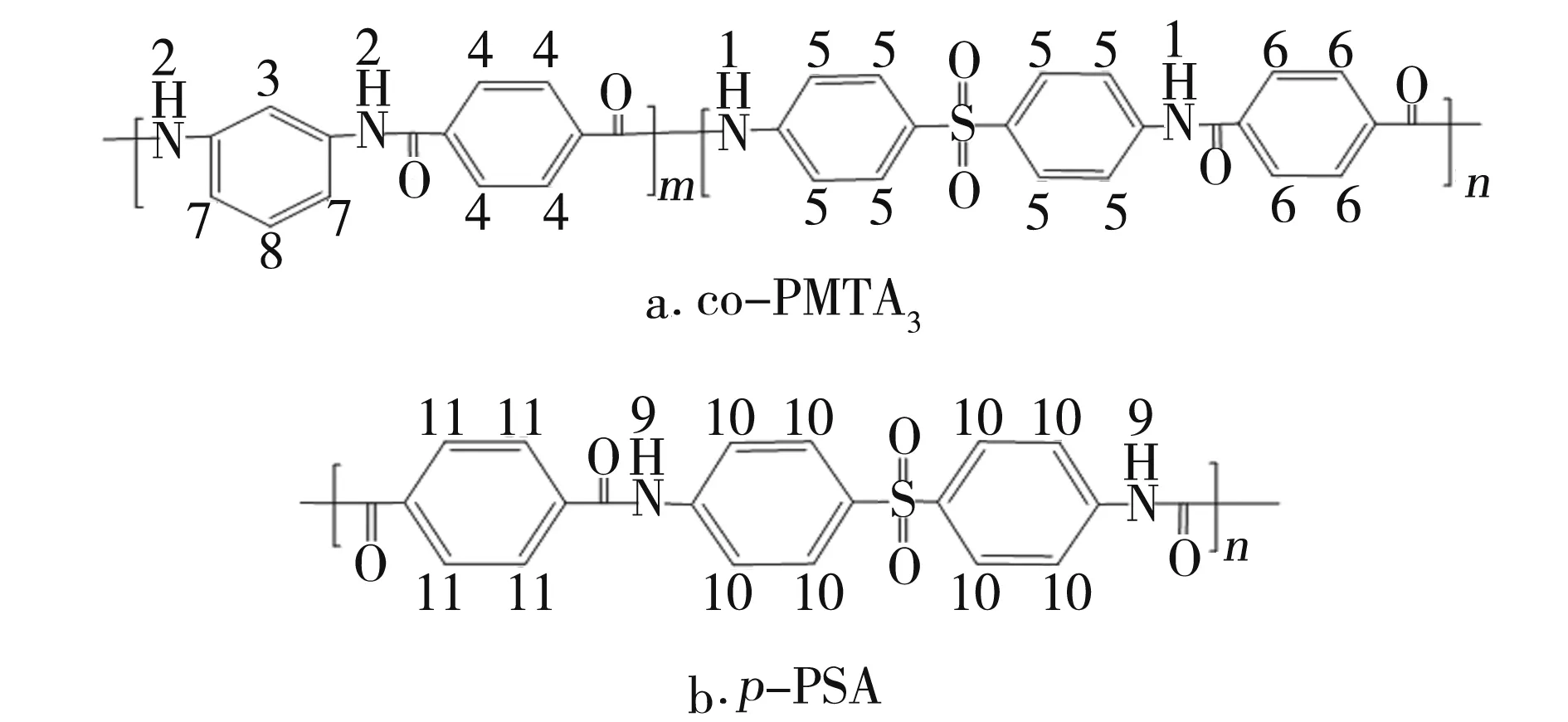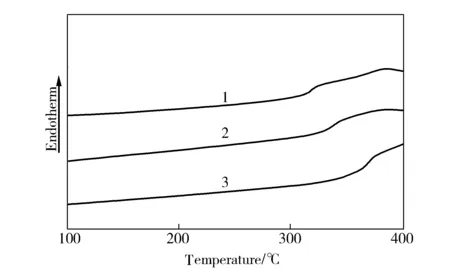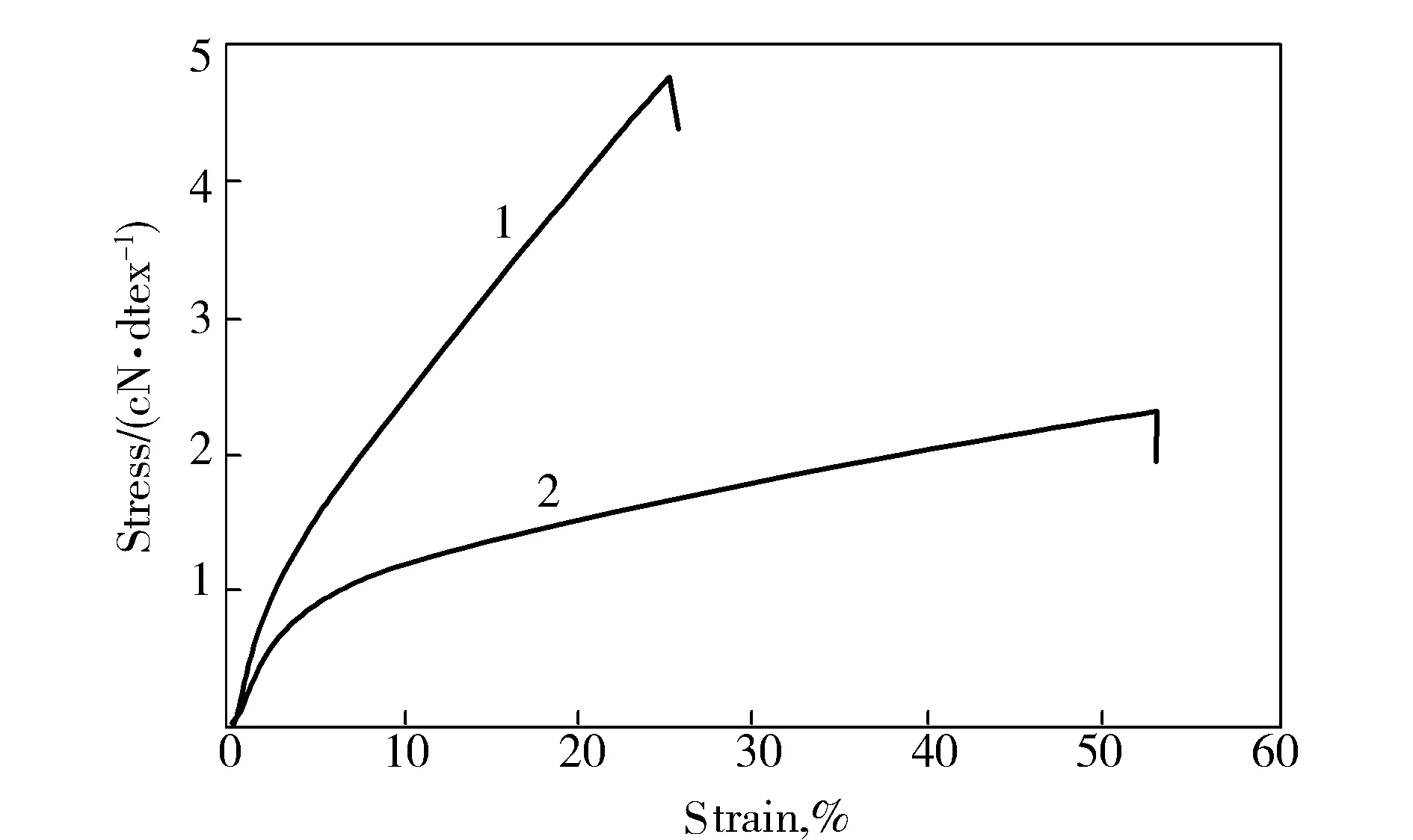Study on solubility of modified poly-m-phenylene terephthalamide and properties of its fiber
2017-06-27WangLinChenShenghuiXieLingjiaoWangXiaofengZhangYouweiLiWengangZhaoJiongxinHuZuming
Wang Lin, Chen Shenghui, Xie Lingjiao, Wang Xiaofeng , Zhang Youwei, Li Wengang, Zhao Jiongxin*, Hu Zuming*
(1.State Key Laboratory for Modification of Chemical Fibers and Polymer Materials, College of Materials Science and Engineering, Donghua University, Shanghai 201620; 2.Shanghai Tanlon Fiber Co. Ltd, Shanghai 201419)
Study on solubility of modified poly-m-phenylene terephthalamide and properties of its fiber
Wang Lin1, Chen Shenghui2, Xie Lingjiao2, Wang Xiaofeng2, Zhang Youwei1, Li Wengang1, Zhao Jiongxin1*, Hu Zuming2*
(1.State Key Laboratory for Modification of Chemical Fibers and Polymer Materials, College of Materials Science and Engineering, Donghua University, Shanghai 201620; 2.Shanghai Tanlon Fiber Co. Ltd, Shanghai 201419)
A modified poly-m-phenylene terephthalamide (co-PMTA3) soluble in DMAc was prepared by incorporating with 4,4′-diamino diphenyl sulfone ( 4,4′-DDS) in backbone and then was spun into fiber via wet spinning. The chemical structure and constitution of co-PMTA3was characterized by1H-nuclear magnetic resonance spectrometry (1H-NMR). The solubility of co-PMTA3was investigated by cloud point titration method (CPM) in ternary phase (co-PMTA3/DMAc/H2O). The thermal property of co-PMTA3was investigated by differential scanning calorimetry (DSC) and was compared with those of all para-position polysulfonamide (p-PSA) and normal polysulfonamide (co-PSA). The as-spun co-PMTA3fiber was drawn at 340 ℃ to a ratio of 1.4, and the hot-drawn co-PMTA3fiber with 10 dtex in the linear density was obtained. The mechanical properties of co-PMTA3were studied. The results indicated that co-PMTA3was the polymer of 4,4′-DDS/m-phenylenediamine/terephthaloyl dichloride at the mole ratio of 2.5/7.5/10; the co-PMTA3possessed excellent heat resistance with a glass-transition temperature of 318.4 ℃ which was lower than those ofp-PSA (367.7 ℃) and co-PSA (343.1 ℃); the co-PMTA3fiber had high mechanical properties with a breaking strength of 4.7 cN/dtex, an initial modulus of 56.5 cN/dtex and a knot tenacity of 2.2 cN/dtex, respectively.
poly-m-phenylene terephthalamide;poly-m-phenylene terephthalamide fiber; 4,4′-diamino diphenyl sulfone; modified polymer; structure
As one of wholly aromatic polyamides (aramids), poly-m-phenylene terephthalamide (PMTA) possesses excellent thermal properties with a softening temperature of 334 ℃ and a weight loss less than 10% under 400 ℃[1-3]. However, PMTA is insoluble in common organic solvents and exhibits extremely high melting temperature that lies above the initial decomposition temperature[4]. It is very difficult to transform PMTA into fiber by wet spinning or melt spinning.
The poor solubility of wholly aromatic polyamides in organic solvents arises from their aromatic structure and amide linkages, which result in stiff rod-like macromolecular chains that interact with each other via strong and directional hydrogen bonds[4].
A modified PMTA (co-PMTA3) was prepared by polycondensation ofm-phenylenediamine (mPDA), 4,4′-diamino diphenyl sulfone (4,4′-DDS) and terephthaloyl dichloride (TPC). The co-PMTA3was soluble in organic solvents due to the following reasons. Firstly, the mole ratio of hydrogen bond donor (—NH—) and the receptor (O) in polymer molecule changed from 1:1 of PMTA into 1:1.25 of co-PMTA3which weakened the intermolecular hydrogen bond strength. Secondly, the regularity of polymer molecule tended to decrease while introducing the new chemical fragment of 4,4′-DDS into the co-PMTA3backbone.
A co-PMTA3fiber was prepared by wet spinning process. The chemical structure and the composition of the co-PMTA3were investigated by1H-nuclear magnetic resonance (1H-NMR) spectra. The solubility of co-PMTA3was investigated by cloud point titration method (CPM). The thermal properties of co-PMTA3were investigated by differential scanning calorimetry (DSC). The mechanical properties of co-PMTA3fiber were characterized.
1 Experimental
1.1 Materials
The initial feed mole ratios of monomers and intrinsic viscosity([η]) of all para-position polysulfonamide (p-PSA),co-PMTA3and normal polysulfonamide (co-PSA) are illustrated in Tab.1. All the samples were provided by Shanghai Tanlon Fiber Co..

Tab.1 Initial feed mole ratios of monomers and intrinsic viscosities of samples
Note:[η] was measured by dual capillary method in 98% sulfuric acid at 25 ℃; 3,3′-diamino diphenyl sulfone (3,3′-DDS).
1.2 Preparation of co-PMTA3fiber
A co-PMTA3fiber was prepared by wet spinning in our laboratory. A co-PMTA3-N,N-dimethylacetamide (DMAc) spinning solution containing 12.5% co-PMTA3by mass fraction was extruded from an insulating charging barrel at (60±1) ℃ into DMAc-water coagulation bath (mass ratio 4:6) at (35±1) ℃. The as-spun co-PMTA3fiber was washed in boiling water and then dried in an oven at 110 ℃. The as-spun fiber was drawn at 340 ℃ to a ratio of 1.4. Finally, the co-PMTA3fiber with the linear density of 10 dtex was obtained.1.3 Characterization
Chemical structure:1H-NMR spectra (400 MHz, dimethyl sulfoxide-d6) of co-PMTA3andp-PSA were recorded on Avance 400 nuclear magnetic resonance spectrometer, Bruker Co., Germany, using tetramethylsilane (TMS) as the internal standard.
Solubility: CPM was carried out according to Hu′s method[5]. The precipitator (DMAc-water mass ratio of 3:7) maintaining at (30±0.5)℃ was added into a certain amount of the polymer solution of samples, whose mass fraction was 1.5% in DMAc at the same temperature. The cloud point was observed by visual inspection and the procedure was repeated at least three times. The average weight of the precipitator added was taken for the components of ternary phase (polymer/DMAc/H2O).
Thermal properties:Accurately (5±0.05) mg of samples were taken for DSC analysis.The glass transition temperature (Tg)ofsampleswascharacterizedbySTA449F3DSCanalyzer,NetzschCo.,Germany,from50to400 ℃ataheatingrateof20 ℃/min,innitrogenatmosphere.
Lineardensityandmechanicalproperties:Themechanicalpropertiesofas-spunandhot-drawnco-PMTA3fibersweremeasuredbyLLY-6Btensiletester:LaizhouElectronicInstrumentCo.,accordingtoChinesenationalstandardGB/T14335—2008.
2 Results and discussion
2.1Chemicalstructure
AsshowninFig.1andFig.2,therearetwotypesofconstitutionalunitsofPMTAandp-PSAinco-PMTA3backbone,andsotwotypesofamidebond.Thepeaksofchemicalshift(δ)at10.49and10.80wereassignedtohydrogenatomsofNo.2andNo.1inFig.2a,respectively.However,theδofamidebondofp-PSAwasat11.84becausetheintensityofhydrogenatomsofamidebondinp-PSAwashigherthanthatofthesameconstitutionalunitinco-PMTA3,whichcausedtheδofamidebondmovingtohighposition.

Fig.1 1H-NMR spectra of co-PMTA3 and p-PSA

Fig.2 Chemical structure of co-PMTA3 and p-PSA
The ratio of integral intensities ofδat 10.49 and 10.80 was 2.95: 1, which was close to the initial feed mole ratio of 4,4′-DDS and mPDA for co-PMTA3. This indicated that the sequence composition of co-PMTA3was consistent well with the given feed ratio of 4,4′-DDS and mPDA copolymerized with TPC.
2.2 Solubility
As presented in Tab.2, the weight ratio of DMAc to water in co-PMTA3/DMAc/H2O system was lower than that ofp-PSA/DMAc/H2Osystembuthigherthatofco-PSA/DMAc/H2Osystemat30 ℃.Theresultindicatedthatthesolubilityofco-PMTA3inDMAcisbetterthanthatofp-PSAbutlowerthatthatofco-PSA.

Tab.2 Components of polymer/DMAc/H2O ternary phase
Note:The more *,the higher solubility.
2.3 Thermal property
As presented in Fig.3, co-PMTA3possessed excellent heat-resistance withTgof318.4 ℃,whichwaslowerthanthoseofco-PSAandp-PSA343.1 ℃and367.7 ℃,respectively,buthigherthanthatofpoly(m-phenyleneisophthalamide) (PMIA)[6].

Fig.3 DSC curves of samples1—co-PMTA3;2—co-PSA;3—p-PSA
2.4 Mechanical properties
As shown in Fig.4, the break strength and the initial modulus of the as-spun co-PMTA3fiber were 2.79 cN/dtex and 43.6 cN/dtex, respectively. Those of the hot-drawn co-PMTA3fiber were 4.7 cN/dtex and 56.5 cN/dtex, respectively. This indicates that the break strength and initial modulus of co-PMTA3fiber increased dramatically and the elongation at break decreased after hot drawing. It may be a result of the enhancement of orientationand closure of voids in co-PMTA3fiber during the hot drawing process. The knot tenacity of hot-drawn co-PMTA3fiber was over 45% of break strength at 2.2 cN/dtex. However, the break strength of hot-drawn co-PMTA3fiber declined when the draw ratio was over 2.0 in our experiment.

Fig.4 Stress-strain curves of co-PMTA3 fiber1—Hot-drawn fiber;2—As-spun fiber
3 Conclusions
a. The1H-NMR spectra indicated that co-PMTA3was the polymer of 4,4′-DDS/mPDA/TPC at the mole ratio of 2.5/7.5/10.
b. By incorporating 4,4′-DDS in backbone, the co-PMTA3was soluble in DMAc, and its solubility in DMAc was better than that ofp-PSA but lower that that of co-PSA.
c. The co-PMTA3was excellent in heat resistance with a highTgof318.4 ℃,whichwashigherthanthatofPMIA,butlowerthanthoseofco-PSAandp-PSA.
d.Theco-PMTA3wasspunintofiberbywetspinning.Themechanicalpropertiesofco-PMTA3fiberwereimprovedbyhotdrawingat340 ℃.Thebreakingstrength,initialmodulusandknottenacityofco-PMTA3fiberwere4.7,56.5and2.2cN/dtex,respectively,atadrawratioof1.4 .
[1]Dine-HartRA,MooreBJC,WrightWW.Aromaticpolyamides[J].JPolymSciCPolymLett,1964,2(4):369-373.
[2]GanLH,BlaisP,CarlssonDJ,etal.Physicochemicalcharacterizationofsomefullyaromaticpolyamides[J].JApplPolymSci, 2010, 19(1): 69-82.
[3]KalashnikAT,PakikarovaNP,DovbiiYV,etal.Comparativeanalysisofthethermaldegradationofpoly-p-bemzamideandpoly-p-phenyleneterephthalamide[J].PolymSciUssr, 1977, 19(12): 3173-3181.
[4]GarcíaJM,GarcíaFC,SernaF,etal.High-performancearomaticpolyamides[J].ProgPolymSci, 2010, 35(5): 623-686.
[5]HuJuan,ZengXiaomei,DongRuijiao,etal.StudyonphasebehaviorofPAN-DMASO-H2Oternarysystembycloud-pointtitrationmethod[J].ChinSynFiberInd,2008,31(4):5-8.
[6]KnillCJ,KennedyJF.Polymerhandbook4thedition[J].CarbohydPolym, 2001, 46(3): 295.
改性聚对苯二甲酰间苯二胺的溶解性及其纤维性能研究
王 林1陈晟晖2谢灵娇2汪晓峰2张幼维1李文刚1赵炯心1*胡祖明2*
(1.东华大学纤维材料改性国家重点实验室,上海 201620;2.上海特安纶纤维有限公司,上海 201419)
采用核磁共振氢谱(1H-NMR)对经4,4′-二氨基二苯砜(4,4′-DDS)改性后的聚对苯二甲酰间苯二胺(co-PMTA3)进行化学结构表征;研究了co-PMTA3的溶解性和热性能,并与对位聚芳砜酰胺(p-PSA)和常规聚芳砜酰胺(co-PSA)进行了比较;采用湿法纺丝方法制得了co-PMTA3初生纤维,将初生纤维经340 ℃热拉伸1.4倍后制得线密度为10 dtex的co-PMTA3纤维,研究了co-PMTA3纤维的力学性能。结果表明:co-PMTA3为4,4′-DDS与间苯二胺及对苯二甲酰氯按其摩尔比为2.5/7.5/10的共聚物;co-PMTA3的溶解性强于p-PAS,但比co-PSA要弱;co-PMTA3有较好的耐热性,其玻璃化转变温度达318.4 ℃,低于p-PSA的367.7 ℃和co-PSA的343.1 ℃;co-PMTA3纤维的断裂强度为4.7 cN/dtex,初始模量为56.5 cN/dtex,打结强度为2.2 cN/dtex。
聚对苯二甲酰间苯二胺 聚对苯二甲酰间苯二胺纤维 4,4′-二甲基二苯砜 改性聚合物 结构
date:13-04-2017; revised date: 15- 05- 2017.
TQ342+.72 Document code:A Article ID: 1001- 0041(2017)03- 0052- 04
Biography: Wang Lin (1985-), male, Ph. D candidate, is engaged in high performance fibers. E-mail:lenwong@126.com.
* Corresponding author: zjxin@dhu.edu.cn;hzm@dhu.edu.cn.
